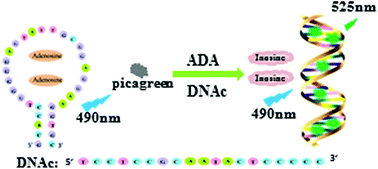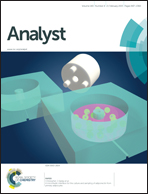Label-free aptasensor for adenosine deaminase sensing based on fluorescence turn-on
Abstract
A label-free and fluorescence turn-on aptamer biosensor has been developed for the detection of adenosine deaminase (ADA) activity with simplicity and selectivity. Adenosine aptamer will form a tight stem-loop structure upon binding with adenosine. In the absence of ADA, only a small quantity of picagreen intercalates into the stem section of aptamer, resulting in a low fluorescence of picagreen when excited at 490 nm. Interestingly, after the addition of ADA, adenosine is hydrolyzed to inosine, and the released aptamer forms double-stranded DNA (dsDNA) with its complementary single-stranded DNAc, followed by the intercalation of picagreen to dsDNA. When the solution is excited, picagreen emits strong green fluorescence. The increased fluorescence intensity of picagreen is dependent on the concentration of ADA. The detection limit of the ADA is determined to be 2 U L−1, which is lower than ADA cutoff value (4 U L−1) in the clinical requirement and more sensitive than most of the reported methods. Compared to other previous ADA sensors, the assay is not only label-free but also a turn-on signal, and possesses properties of lower cost and simpler detection system. Furthermore, this label-free strategy is also applicable to the assay of other enzymes and screening of corresponding inhibitors.


 Please wait while we load your content...
Please wait while we load your content...